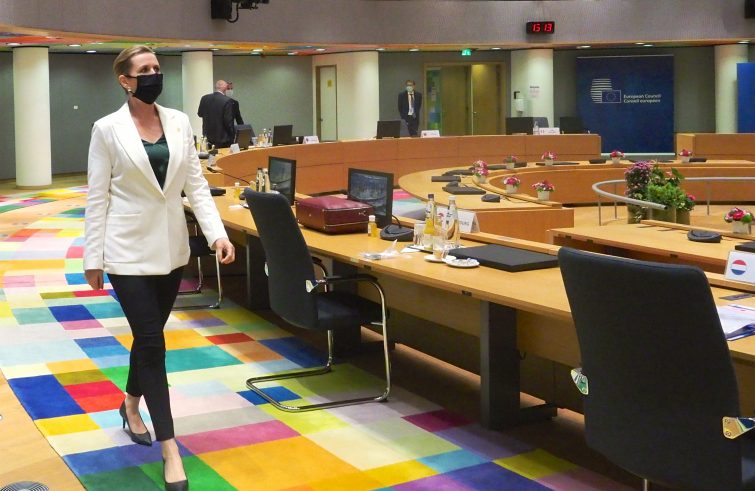
Whenever a woman is appointed to a position of great political, economic, academic or social responsibility for the first time, it makes headlines: the first woman president of the European Commission (Ursula von der Leyen), the first woman at the helm of the European Central Bank (Christine Lagarde), and recently the first woman to chair the Paris stock exchange (Delphine d’Amarzit). And for the first time in the last few weeks, a large number of women have simultaneously been appointed leaders of European governments: Kaja Kallas in Estonia, Sanna Marin in Finland, Mette Frederiksen in Denmark, Erna Solberg in Norway, Ingrida Simonyte in Lithuania, Katrín Jakobsdóttir in Iceland, Ana Brnabic in Serbia along with, needless to say, Angela Merkel in Germany. Women have also been chosen as Presidents of their Republic: Zuzana Čaputová, lawyer and activist, in Slovakia, Justice Katerina Sakellaropoulou in Greece, Maia Sandu in Moldova, Salomé Zourabichvili in Georgia.
 Major obstacles. There is great pride in a woman achieving leadership positions, reverberating to every woman as a personal accomplishment. Each successful woman is a woman who overcame more obstacles than their male counterparts, sending out a message of encouragement to all others. Thus Europe’s sky has a pinker shade. But far from being a question of colour, it’s “a step towards normality”, said Stephan Eisle, renowned German political analyst whose career included being Helmut Kohl’s speechwriter from 1983 to 1987. “We Germans have long been accustomed to a woman leading the country,” Eisle remarked, and perhaps in Northern Europe it’s a given in view of its cultural context, whereas in countries in southern or eastern Europe it’s a greater challenge. It goes without saying that even in the North none of those women are political leaders “because they are women. In fact they are in leadership positions because of their competence.”
Major obstacles. There is great pride in a woman achieving leadership positions, reverberating to every woman as a personal accomplishment. Each successful woman is a woman who overcame more obstacles than their male counterparts, sending out a message of encouragement to all others. Thus Europe’s sky has a pinker shade. But far from being a question of colour, it’s “a step towards normality”, said Stephan Eisle, renowned German political analyst whose career included being Helmut Kohl’s speechwriter from 1983 to 1987. “We Germans have long been accustomed to a woman leading the country,” Eisle remarked, and perhaps in Northern Europe it’s a given in view of its cultural context, whereas in countries in southern or eastern Europe it’s a greater challenge. It goes without saying that even in the North none of those women are political leaders “because they are women. In fact they are in leadership positions because of their competence.”
 Each with their respective backgrounds. Each one of the women currently leading the governments of seven European countries, and a number of European institutions, have specific areas of expertise, their own decision-making styles, different backgrounds, political affiliations and differing ages. Sanna Marin was born in 1984, while Angela Merkel was born in 1954; Danish PM Mette Frederiksen is a member of the Social Democratic Party and leads a centre-left government; Norwegian leader Erna Solberg chairs the Conservative Party and is at the helm of a right-wing coalition. Ingrida Simonyte is a trained economist, like Ana Brnabic; Kaja Kallas is an attorney. Besides their education, age and party affiliation, they differ in their disposition and personal background. According to Eisle, political affiliation is the most decisive factor, regardless of gender. In Germany, for example, Angela Merkel’s European policy was no different from Helmut Kohl’s, nor will it differ from whoever from the CDU, male or female, should succeed her as Chancellor.
Each with their respective backgrounds. Each one of the women currently leading the governments of seven European countries, and a number of European institutions, have specific areas of expertise, their own decision-making styles, different backgrounds, political affiliations and differing ages. Sanna Marin was born in 1984, while Angela Merkel was born in 1954; Danish PM Mette Frederiksen is a member of the Social Democratic Party and leads a centre-left government; Norwegian leader Erna Solberg chairs the Conservative Party and is at the helm of a right-wing coalition. Ingrida Simonyte is a trained economist, like Ana Brnabic; Kaja Kallas is an attorney. Besides their education, age and party affiliation, they differ in their disposition and personal background. According to Eisle, political affiliation is the most decisive factor, regardless of gender. In Germany, for example, Angela Merkel’s European policy was no different from Helmut Kohl’s, nor will it differ from whoever from the CDU, male or female, should succeed her as Chancellor.
- Kaja Kallas
- Ingrida Simonyte
- Erna Solberg
 Distinguished personalities. In any event, the group photo of the Heads of State and Government meetings will be more colourful, if only because of the greater number of women. Indeed, Eisle said, “women have played an active role in the construction of Europe. Suffice it to mention Simon Weil”, President of the European Parliament from 1979 to 1982. However, the list is short. There have certainly been other women at European Council summits over the years: from Margaret Thatcher to Theresa May, from Lithuanian Dalia Grybauskaitė to Merkel herself, on the European political scene for 17 years, but even that list is by no means a long one…
Distinguished personalities. In any event, the group photo of the Heads of State and Government meetings will be more colourful, if only because of the greater number of women. Indeed, Eisle said, “women have played an active role in the construction of Europe. Suffice it to mention Simon Weil”, President of the European Parliament from 1979 to 1982. However, the list is short. There have certainly been other women at European Council summits over the years: from Margaret Thatcher to Theresa May, from Lithuanian Dalia Grybauskaitė to Merkel herself, on the European political scene for 17 years, but even that list is by no means a long one…
 Being in top positions. A positive aspect of a greater presence of women in leadership roles is “that it better represents societal composition”, Eisle said. Admittedly, “women see things differently compared to men”, just as a young or old person’s perspective is different, or that of people with different geographical and cultural backgrounds. A significant difference between the male and female models, however, is integration into society, what the Germans call ‘sozialisierung’, i.e. “the way in which a person is socially integrated.” Women’s social integration depends to a large extent on the family, whereas men disengage themselves from family responsibilities more readily and more swiftly.
Being in top positions. A positive aspect of a greater presence of women in leadership roles is “that it better represents societal composition”, Eisle said. Admittedly, “women see things differently compared to men”, just as a young or old person’s perspective is different, or that of people with different geographical and cultural backgrounds. A significant difference between the male and female models, however, is integration into society, what the Germans call ‘sozialisierung’, i.e. “the way in which a person is socially integrated.” Women’s social integration depends to a large extent on the family, whereas men disengage themselves from family responsibilities more readily and more swiftly.
 A second, subtler difference, Eisle pointed out, lies in the fact that women’s collective imagination is less about “making it to the top”, and they have struggled and continue to struggle more than men to attain top leadership roles. “It has not been a customary practice in history”, and therefore it’s harder. The fact is – this is certainly true in Italy, where we are much less used to having women in positions of responsibility – that they are judged more harshly (and sometimes with greater viciousness). But step by step, as increasing numbers of women are appointed to leadership roles, the sound and necessary re-shaping of the political, economic, and cultural world as a whole, is moving forward.
A second, subtler difference, Eisle pointed out, lies in the fact that women’s collective imagination is less about “making it to the top”, and they have struggled and continue to struggle more than men to attain top leadership roles. “It has not been a customary practice in history”, and therefore it’s harder. The fact is – this is certainly true in Italy, where we are much less used to having women in positions of responsibility – that they are judged more harshly (and sometimes with greater viciousness). But step by step, as increasing numbers of women are appointed to leadership roles, the sound and necessary re-shaping of the political, economic, and cultural world as a whole, is moving forward.














